by Bruce Steele | Jul 5, 2016 | WF News
Summertime and the Living is Hectic
Our spring crop of Manga piglets is at the marauding age – rambunctious escapees who slip through fences at will and nip at Bruce’s heels on his feeding rounds, or shoot through his legs to get first crack at the barley bowls. We’re also making regular overnight trips to the USDA harvest facility in Fresno, a four hour midnight drive, now that orders are increasing (and we’ve found a reliable piggysitter). So “R & R” is a scarce commodity these days as summer is upon us.
But we’re not complaining! We’re delighted that more and more foodies are discovering the magical flavor of Winfield Mangalitsa. With grateful thanks to Edible Santa Barbara magazine, coordinators of the Tastes of Communities event at Santa Barbara’s exclusive Bacara Resort in April (see our Spring Update, part 3), we connected with Executive Chef Jeffrey O’Brien. Chef Jeff now features Winfield Mangalitsa pork on the menu of the Bacara’s Bistro restaurant. Succulent Winfield Mangalitsa loin roasts are popular with Bacara guests as well. Chef Jeff also served Winfield Mangalitsa belly in his Korean BLT sliders at Fiesta Ranchero, a special event in Goleta in June (to raving acclaim, we heard).
Edible also introduced us to another great customer, Barbareño in Santa Barbara. Executive Chef Julian Martinez now features Winfield Mangalitsa in the restaurant’s acclaimed Plate of Pork.
When Chef Julian informed us that Barbareño was hosting the Edible summer issue release party and invited us to participate, the event seemed a perfect fit — a great way to celebrate the magazine and promote our Mangalitsa simultaneously at one of our favorite restaurants. (Chef Julian creates amazing pork dishes with our heritage wooly pigs — magical flavor indeed!)
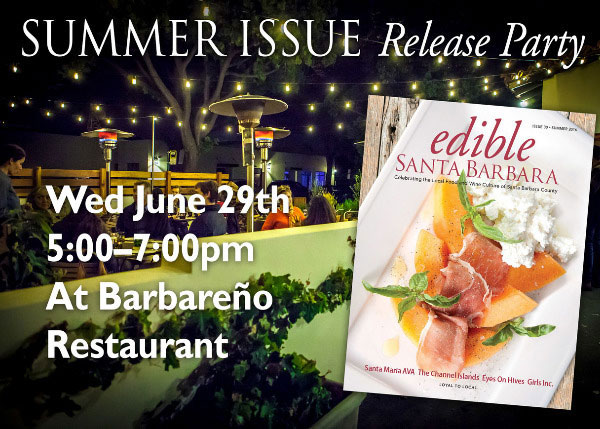
Partygoers lined up more than a hundred strong outside Barbareno to sample Chef Julian’s Cuban-inspired Mangalitsa pork sandies – melt in your mouth delicious!
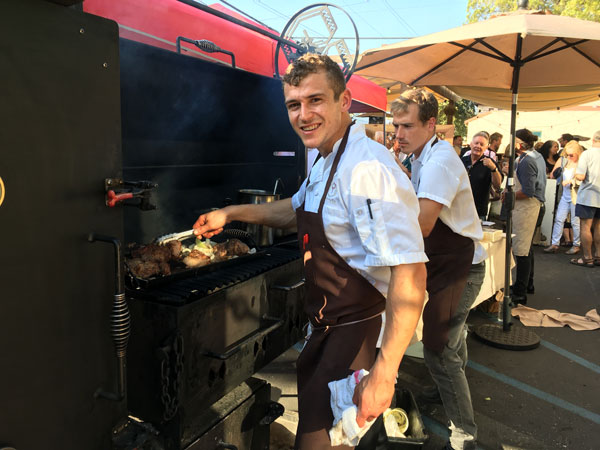
Meanwhile, Winfield Farm, in partnership with Larder Meat Co. (owners Grace and her husband Chef Jensen Lorenzen are Bruce’s niece and nephew), offered tasty bites featuring Winfield pork meatballs skewered with grapes and dipped in Chef Jensen’s special sauce, and guanciale cured for us by Alle Pia skewered with pineapple chunks, all grilled on Jensen’s yakitori grill.
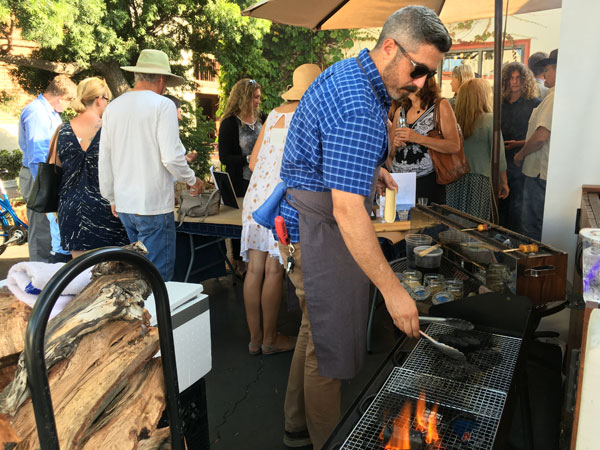
The party at Barbareño was a grand success in multiple ways: Edible Santa Barbara magazine’s summer issue received a royal sendoff, Barbareño gained even more acclaim as one of Santa Barbara’s most innovative restaurants, and Winfield Farm helped spread the word about The Larder Meat Company’s new Larder Club — a CSA-style monthly meat box that features premium quality beef, chicken and pork from local sustainable family farmers. Of course the pork in the box is Mangalitsa from Winfield Farm.
All in the Family
We’re delighted to participate in the Larder Club, the creation of Chef Jensen and Grace, whose venture has struck a chord in the local community, as memberships have soared in their first month of operation from 32 boxes to 70 and growing. Each membership is called a “share”.
Here are pertinent details from the Larder Co. website:
WHAT’S IN THE BOX?
[Members] will receive a 12-13 pound “share” of locally sourced and sustainably raised meats. This will typically include the following: 8 lbs of Beef (mixture of steaks, roasts, and ground), 1 whole chicken (3-3.5 lbs average), 1.5 lbs of Pork (1lb of ground and a half pound of Bacon), a recipe card with preparation tips and at least one “special item of the month” like brine for the chicken, steak rub, or my favorite baste sauce. This share is intended to be a one-month supply of locally raised meat for a family size of 2-4 people.
WHY IS IT CALLED A SHARE?
As a member of the Larder Meat Co. your money is going directly to local Ranchers to purchase whole animals. After processing at a USDA Certified butcher, each animal is divided equally amongst the members. Think of it as purchasing stock in a publicly traded company, but with much tastier options and a better ROI – feeding your family in an environmentally responsible manner and supporting our Local Food Economy!
Here’s how it works:
1. WE FIND THE FARMS THAT DO IT RIGHT
2. YOU PLACE YOUR ORDER ONLINE (WE CURRENTLY HAVE ONE OPTION, $199 FOR A 12-13 LB BOX)
3. WE DELIVER A CURATED BOX OF LOCALLY RAISED MEATS TO YOUR DOOR ONCE A MONTH
4. YOU CHECK ‘MEAT’ OFF OF YOUR GROCERY LIST AND COOK DELICIOUS MEALS THAT YOU CAN FEEL GOOD ABOUT!
Check out the Larder Meat Co. website for more information.
Here are some scenes from Barbareno’s Edible Santa Barbara summer release event.
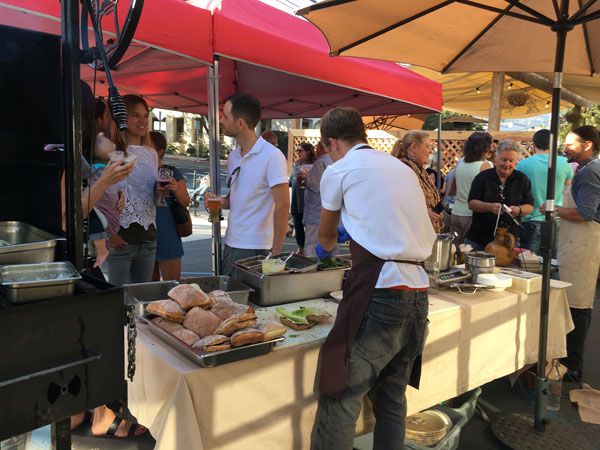 Barbareno served Cuban pork sandies featuring Winfield Mangalitsa at the Edible SB summer release party
Barbareno served Cuban pork sandies featuring Winfield Mangalitsa at the Edible SB summer release party

Bruce Steele explained Winfield Farm’s sustainable solar-powered farm practices, including natural GMO-free feed, to produce top quality Mangalitsa pork

A happy guest enjoys a taste of magic — Mangalitsa meatball with grapes

Grace Lorenzen (on right), co-owner of Larder Meat Co., explains how the Larder Club works – a monthly meat box delivered to the community and featuring sustainably raised local beef, chicken and Winfield Farm Mangalitsa pork

by Bruce Steele | Jun 23, 2016 | Mangalitsa Pigs
The true story of how Mangalitsas first came to the U.S…. Winfield Farm pigs are descendants from this original herd.
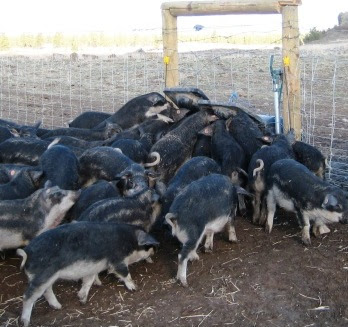
A NEW PIG IN TOWN – story and photo by Heidi Broadhead
Heath Putnam just wanted some tasty pork. And he figured he was not alone.
“There are certain things that people pay money for willingly. They hit people on a really, really low level. Good food is something like that. Porn is something like that. Prostitution. Drugs,” he said. “When I tasted the Mangalitsa, I knew it was one of those things.”
Mangalitsa pigs, also known as Wollschwein or Wooly pigs (the name that Putnam chose for his business), are native to Hungary. This lard-type breed of pig (i.e., valued for its natural marbling as opposed to American pigs that are bred and fed to be lean) was not available in the United States until last fall, when Putnam imported them from Austria.
Putnam first tasted a Mangalitsa sausage when he was working in Europe. He and his wife and business partner, Zuzana, were repeatedly disappointed by the quality of meat here. They decided to import a small herd of Swallow-Bellied Mangalitsa, a close kin to the wild boar, because they thought this nomadic, foraging pig would be the European breed most likely to thrive in the cold, dry Palouse region of Washington State.
Putnam had never been a farmer, and he had no interest in becoming one. He found a local rancher, Gary Angell of the Rocky Ridge Ranch 30 miles west of Spokane, to raise the pigs. Angell’s area of expertise was forage-raised beef. When he told neighboring farmers about the project, he mostly heard responses like “You’re crazy” and “They’re all gonna die out here.”
Putnam planned to go to Austria with Angell to select and purchase the Mangalitsa pigs. Due to some last-minute health problems, Angell had to stay behind and Putnam went ahead on his own, visiting nine farms and amassing as much information as he could for Angell on how to properly breed, raise and finish the pigs.
He joined the Mangalitsa Breeder’s Association, a group dedicated to reintroducing the breed to Austria (it disappeared temporarily in the 1970s) and to maintaining the quality of the breed. He studied charcuterie with a butcher and got whole-hog tips from a renowned Austrian chef.
“He went over to buy nine pigs,” Angell said. Putnam instead chose to import 29 hogs—two boars and 27 sows, the maximum that could fit in one cargo hold. This allowed him to maximize genetic diversity with three to four lines.
Challenges ensued. After being quarantined in Austria from March to May 2007, Putnam’s Mangalitsas were transported to a quarantine center in upstate New York. From May 12 to August 12, the pigs underwent various tests, delaying their stay long enough for 65 piglets to be born in quarantine (and accruing $1,000 per pig in boarding costs). Wooly Pigs lost 10 piglets on the truck between New York and Spokane. At the ranch, the piglets had a negative reaction to a vet-recommended vaccination and they lost one more.
In November, they slaughtered three piglets for samples and to fill their first restaurant order—from the French Laundry—which revealed the lack of USDA-approved processing facilities in their region that could deal with their special slaughtering needs—like keeping the pigs in a low-stress environment leading up to the slaughter, which is important to Wooly Pigs’ philosophy of humane farming and something that Putnam maintains is crucial to preserving the meat’s flavor.
Tasting the Meat
I visited Rocky Ridge Ranch last November. We sat around the kitchen table—Putnam, Angell, Angell’s wife So and me.
“We are the first four people to try the North American Mangalitsa,” Putnam said as he spooned the three-month-old roasted piglet meat onto our plates. “Not like anything you’ve ever tasted, right?”
The dark meat was so moist it crumbled as soon as the fork touched it. We ate the jowls. We chewed the meat off tiny ribs. We ate soft fat that tasted more like cream or butter. We each had different ways of describing what the meat tasted like, but we all agreed on one thing: This does not taste like pork.
Eating a Mangalitsa is like eating a pig from a hundred years ago. It’s a completely different kind of animal. Since the middle of the 20th century, U.S. pork demand has gone the way of lean—lard was replaced by vegetable oils for cooking, and people began to prefer meatier cuts. Pigs were bred to be lean and to grow very quickly.
Old-style Mangalitsas (what Putnam calls on his website “unimproved breeds”), on the other hand, come from a line that was primarily raised in Hungary, Mangalitsas cross-bred with Serbian wild boars.
“They’ve been behind the Iron Curtain since the ’50s,” said Angell. “Maybe that has something to do with it.”
One look at these near-wild beasts will tell you that this is no ordinary pig. The sows have high, curved backs with coarse gray, black and brown hair on their backs and falling over their eyes. They lift and throw giant rocks with their mud-covered snouts. A couple of them nibbled at the back of my leg, which made me a little nervous after hearing that #5 had recently bit Angell, leaving a pretty nasty bruise. Apparently, as long as I wasn’t a coyote or some other predator trying to get to a piglet, I was safe. (Mangalitsas are very protective mothers.)
And most of the pigs we eat in Washington State come from somewhere else. Although exact consumption data is not available, the Washington Department of Agriculture estimates that 90 to 95 percent of pork consumed here is from out of state, primarily from large producers in the Midwest. (As a comparison: As of December 1, 2007, Washington had 29,000 total hogs and pigs. Iowa, by contrast, had 18.2 million.) Input methods vary, but the predominant feed for pen-raised pigs in the United States is corn and soybean meal.
Mangalitsas are self-sufficient and forage in social groups without needing to be fed or moved from one spot to another, so they are perfectly at home in their 30-acre field. Wooly Pigs raises all their pigs (Mangalitsas and Berkshires) on protein-rich crops in the summer. In the fall and winter, they forage on dry oats, peas, sunflowers, turnips, weeds and grasses. They are finished on hay (alfalfa-barley) and a mix of local grains.
“The quality of fat is amazing,” the Herbfarm’s Executive Chef Keith Luce said of Wooly Pigs’ Berkshires, which are raised on the same diet as the Mangalitsas. “It’s embarrassing, actually. We were taking fat and spreading it on bread like butter.”
woolypigs.com
Heidi Broadhead is a regular contributor to Amazon’s books blog, Omnivoracious, and is currently writing monster descriptions for the next edition of Beasts! for Fantagraphic Books.
by Bruce Steele | Jun 3, 2016 | Uncategorized
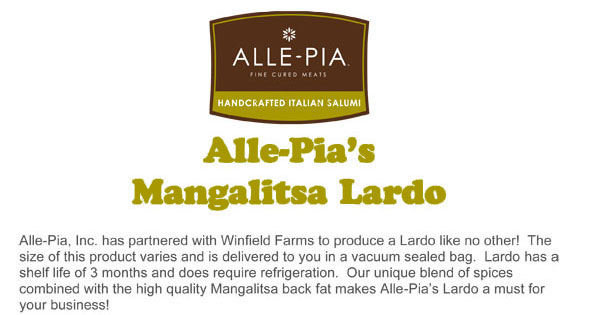 Call Alle-Pia, Inc. at (805) 461-6800 or email at: info@allepiasalumi.com for pricing.
Call Alle-Pia, Inc. at (805) 461-6800 or email at: info@allepiasalumi.com for pricing.
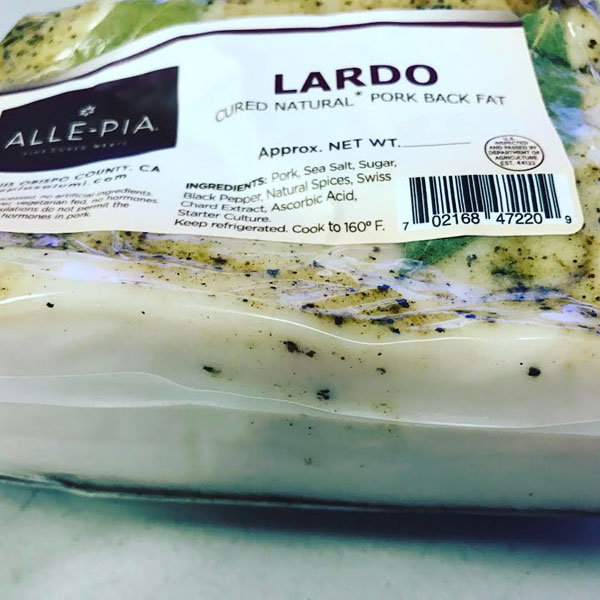
by Bruce Steele | Apr 25, 2016 | WF News, What Chefs Say
Winfield Farm Mangalitsa Wowed the Crowd at the 3rd Annual Santa Barbara Food and Wine Neighborhood Market Tour at the Bacara Resort
Capping our spring fling promoting Winfield Farm Mangalitsa pork, we were honored and delighted to represent the Santa Ynez Valley farm community, among Santa Barbara County’s most talked about culinary neighborhoods, all gathered on a sunny Sunday in April in the beautiful surroundings of the Bacara Resort’s Courtyard, to celebrate and benefit The Julia Child Foundation.
The Food and Wine Neighborhood Market Tour at the Bacara, a world-class resort overlooking the Pacific Ocean near Santa Barbara, featured tastings by dozens of local and nationally-acclaimed chefs, artisans, winemakers and farmers. Our Winfield Farm table served up Mangalitsa meatballs dipped in secret sauce created by Chef extraordinaire Jensen Lorenzen (Bruce’s nephew), which he fired on his yakitori grill. Bruce and I slathered artisan crackers with Mangalitsa Nduja – a new Winfield Farm product created by our salumi partner Alle Pia from cured Mangalitsa salami Barolo, ground and infused with Palmina Nebbiolo wine, with sun dried tomatoes, garlic and seasonings. Nduja’s texture is reminiscent of tomato paste, but the flavor is out-of-this-world piquant!! Alle Pia partner Alex Pellini also joined us and offered their hand-crafted salami Barolo and Tartufo.
The event was patterned after a farmers’ market, hours 11 AM to 2 PM. Throngs of people table hopped, sampling food and drink from diverse communities including Santa Barbara’s eclectic Funk Zone, Old Town Goleta, the Arts District, Los Alamos and Lompoc, as well as SY Valley.
Food and wine presentation tables ringed the courtyard, while dozens of cloth-draped tea tables scattered about offered tasters a place to sit and enjoy the food and drink.
Event presenters all committed to providing 500 servings – and between the meatballs, Nduja and salami we must have at least doubled that quantity. It seemed that as soon as Chef Jensen set out a tray of Manga meatballs, they vaporized — and the same with the Nduja and salami. Then we noticed the same people coming back again and again … a group of people sitting at the tea table nearest our stand had become fast fans of Mangalitsa pork!
The crowd came early and many lingered until the last taste and sip were stowed away. The Bacara’s Neighborhood Market Tour was a great way to spend a sunny Sunday — educating friends and neighbors about the magical flavor of Mangalitsa pork. Many stopped by to thank us for sharing, and to compliment Winfield Mangalitsa as the best bite of the event. The Chefs at the Bacara also took note. Winfield Mangalitsa pork is now featured on the Bacara Bistro’s breakfast menu! And the Chef told us they’re opening a new restaurant soon, and expressed interest in Winfield Mangalitsa chops… We’re excited about that prospect!
Photo gallery:
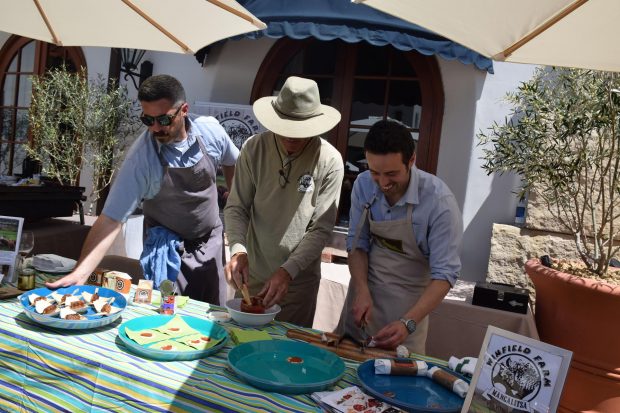 Chef Jensen, Bruce and Alex lay out Winfield Mangalitsa tasting at the Bacara
Chef Jensen, Bruce and Alex lay out Winfield Mangalitsa tasting at the Bacara
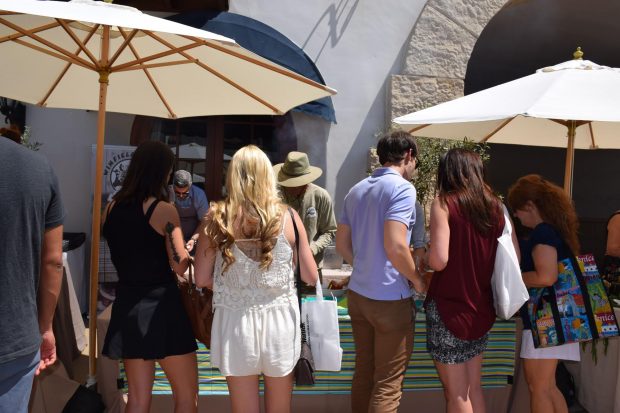
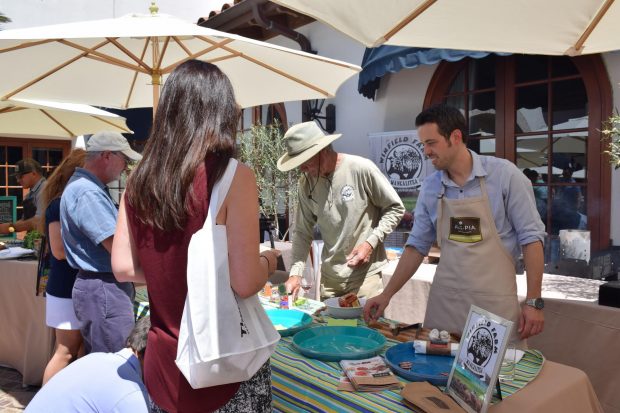
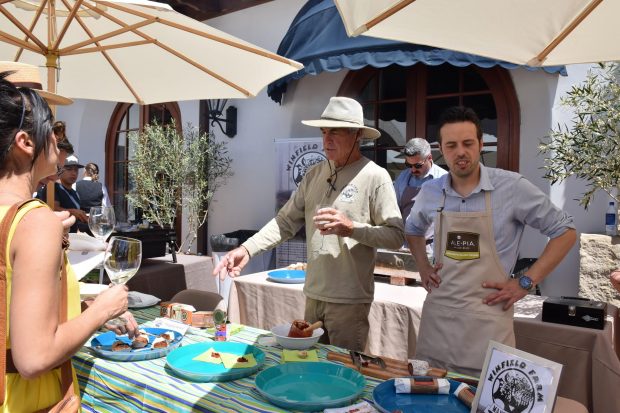 Event goers crowd the Winfield Farm table at the Bacara Taste of the Communities Event
Event goers crowd the Winfield Farm table at the Bacara Taste of the Communities Event
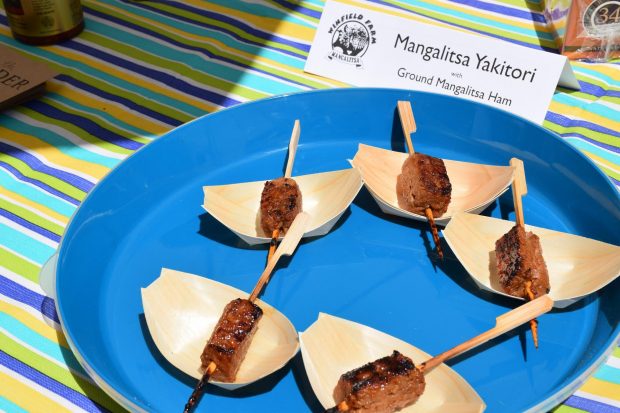 Mangalitsa meatballs yakitori
Mangalitsa meatballs yakitori
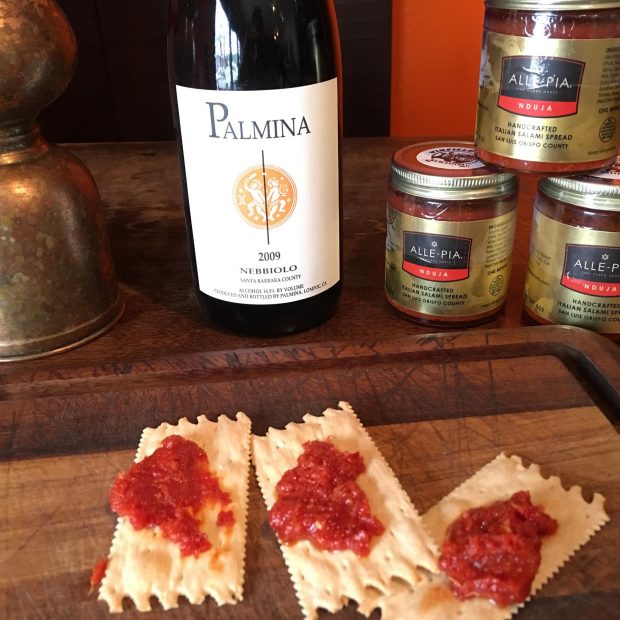 New product: Mangalitsa Nduja infused with Palmina Nebbiolo
New product: Mangalitsa Nduja infused with Palmina Nebbiolo
by Bruce Steele | Mar 25, 2016 | WF News, What Chefs Say
Winfield Farm Presents the Magic of Mangalitsa at the American Culinary Federation Chefs de Cuisine of California, Los Angeles Chapter
Cochon 555 was just the start of a whirlwind weekend in LA, promoting Winfield Mangalitsa pork!
Our great adventure began with a chance meeting with Chef Daniel Csotai, who visited Winfield Farm in search of backfat to make Hungarian bacon. A Hungarian who grew up with Mangalitsa pigs and is passionate about their flavor profile, Chef Daniel now also happens to be the secretary of the American Culinary Federation Chefs de Cuisine of California, Los Angeles Chapter. CCAC is a fraternal service organization and member of the national American Culinary Federation, the oldest and largest chef organization in America.
Chef Daniel agreed to help us reach out to the Los Angeles culinary community, introduced us to the CCAC education chair, and that’s how we wound up showcasing Winfield Mangalitsa at a special CCAC event – Bourbon and game tasting, hosted by CCAC member Chef Hugo Miranda at the Four Points by Sheraton Hotel LAX. Except in this case, the “game” was Mangalitsa pork. More serendipitous, the event took place the day after Cochon 555, so after securing a reliable pig-sitter, we got to spend a night in LA – a mini-vacation.
Bruce opened his presentation with a history of Mangalitsa pigs, who nearly went extinct until Spanish prosciiutto-makers discovered that Mangalitsa is on par with famed Iberico de Bellota ham. In fact, Mangalitsas are the only other pig besides Iberico approved to be labeled “pata negra”.
Bruce told chefs how Winfield Farm Mangalitsas are raised – on pasture, with a non-GMO diet consisting of barley and organic produce, finished with acorns and walnuts. Barley preserves the quality of the luscious white fat, he said. Corn turns the fat rancid over time — not a good thing when you’re hanging a ham to dry cure for a couple of years.
Bruce’s nephew, chef Jensen Lorenzen, attended the event with us and extolled the attributes of Mangalitsa pork from a chef’s perspective. Mangalitsa’s prime value is for charcuterie, and several chefs asked technical questions about the curing process and sausage-making. Making sausage is another excellent thing to do with Mangalitsa fat, which is very high in oleic acid – the good fat!
Then came the tasting.
Chef Hugo Miranda has served as Executive Chef in some of the most high-end restaurants in the Los Angeles area. Adding to his experience as a high-end culinarian, Chef Miranda spent half a year in Costa Rica enhancing his culinary expertise in fine local Asian fusion cuisine. His creativity preparing Winfield Mangalitsa loin and rib roast was inspirational – a real tribute to the magic of Mangalitsa pork.
After the feast he revealed his secret: he marinated the roast in a brine with orange juice and herbs for two days! Chef Hugo’s Mangalitsa entrée was melt-in-your-mouth delicious.
His dessert – Mangalitsa bacon-infused bread pudding – was yummy also (although by that time we were so full we couldn’t finish it all).
Chef Hugo received an award from the CCAC for his commitment to the association; it was well deserved. He promised before the event, “Yes I’ll make sure we showcase Mangalitsa!!!” He was true to his word: he really did it !!
Thanks again, Chef Hugo! Everyone at the event loved Winfield Mangalitsa pork!
Photo gallery:
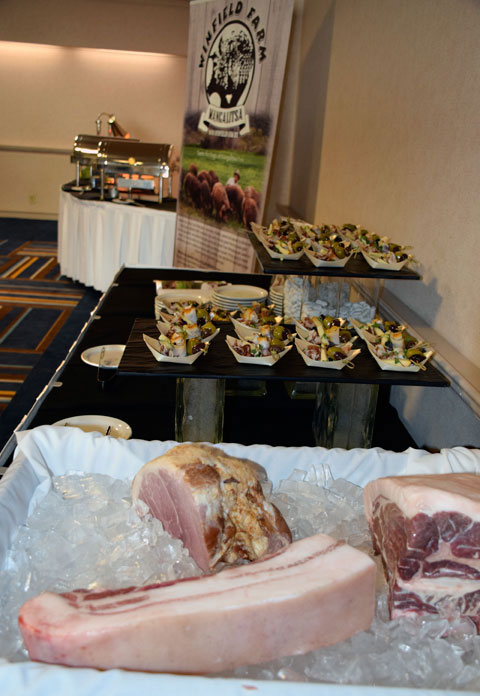 Winfield display at CCAC
Winfield display at CCAC
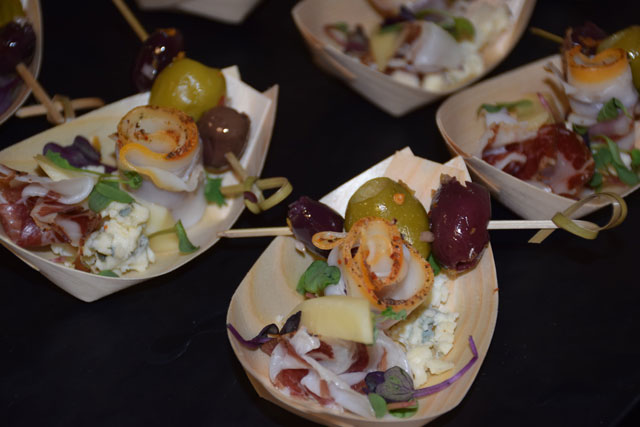 Charcuterie close-up — Coppa, Lomo and Fiocco
Charcuterie close-up — Coppa, Lomo and Fiocco
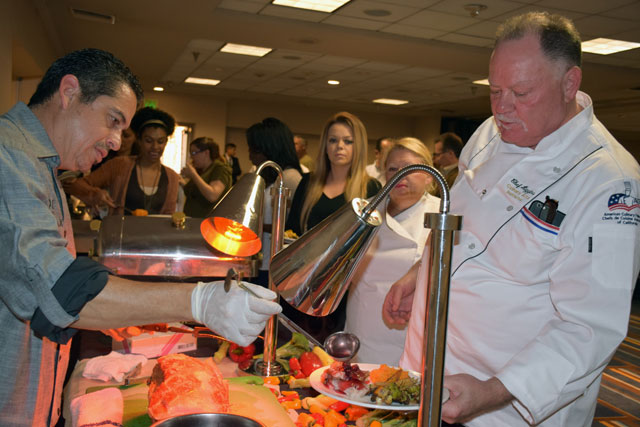 Serving Winfield Mangalitsa loin roast
Serving Winfield Mangalitsa loin roast
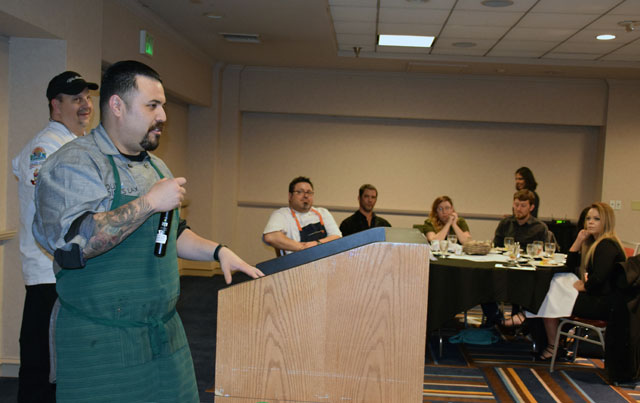 Chef Hugo reveals his secret to preparing mouth-watering Mangalitsa
Chef Hugo reveals his secret to preparing mouth-watering Mangalitsa
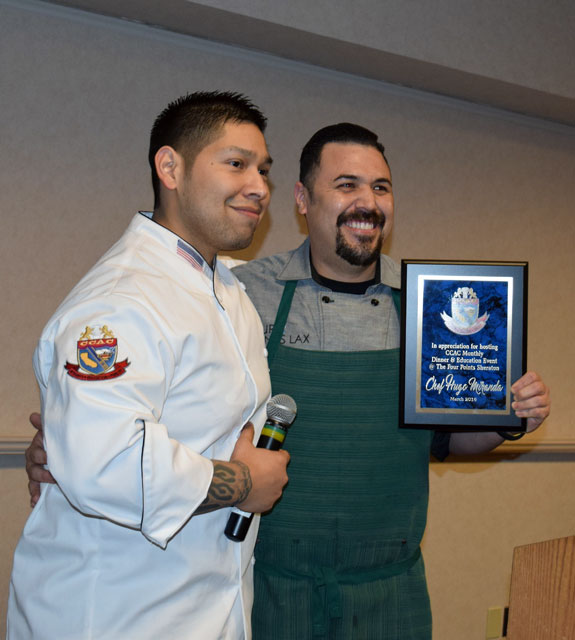 CCAC presents award to Chef Hugo
CCAC presents award to Chef Hugo
 Barbareno served Cuban pork sandies featuring Winfield Mangalitsa at the Edible SB summer release party
Barbareno served Cuban pork sandies featuring Winfield Mangalitsa at the Edible SB summer release party




















